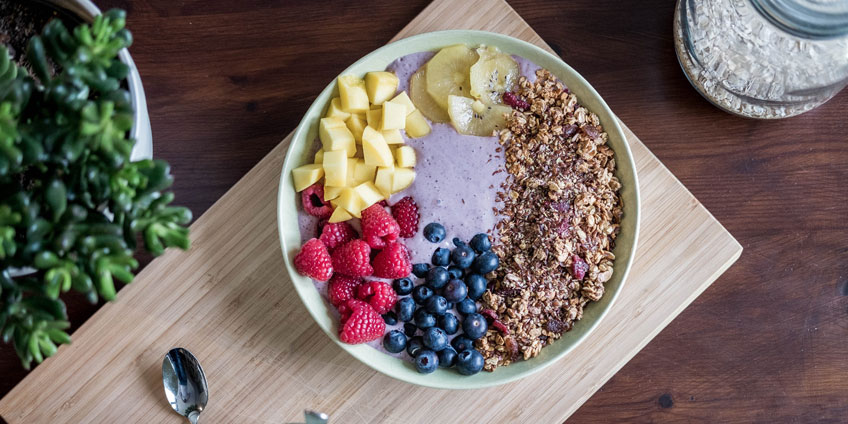Bloat happens. It may be because you’ve eaten something that’s caused your stomach to start working overtime, or had a meal that’s a little high in salt, causing some water retention in your body.
But what if your stomach is stirring up more than just gas?
If you’ve ruled out food poisoning and still feel a mix of cramping, diarrhea, or acid reflux throughout the day, you might be experiencing inflammation. And it turns out even “healthy” foods you eat, such as fruits, vegetables, dairy products, legumes, and grains, could trigger inflammation in your body.
While this often affects people with super sensitive stomachs, irritable bowel syndrome (IBS), and allergies, loading up on foods high in FODMAPs (fermentable oligo-, di-, mono-saccharides and polyols) could trigger digestive issues. Or you may be eating the typical American diet (aka the modern diet) more often than you think. Both diets mess with our gut microbiome and essentially leave less room for good bacteria.
Fortunately, there’s an answer to that: Avoid the triggering foods, especially ones with short-chain carbohydrates.
That’s why we’ve created this low-FODMAP and anti-inflammatory shopping guide as a tool for you to kick-start your health journey and break up with your inflammation symptoms so you can start living a healthier, happier you!
4 recipes to fuel your body
1. Gut Repair Soup
You are what your microbiome eats. The foods you choose play a significant role in the prevention of degenerative diseases by improving your microbiome environment. If all disease begins in the gut, as Hippocrates once said, then so does healing. This Gut Repair Soup is a winner in both taste and healing properties!
Ingredients:
-
- 1 Bunch of Broccoli with stalks
- 1 Zucchini
- 1 Stalk of Celery
- 3-4 tsp of Olive Oil
- 1 Large Sweet Potato or Squash (optional)
- 1 Bunch of Green Leafy Veggies such as Spinach, Chard, Collards, Kale or Dandelion Greens
- Sea Salt to taste
Directions:
- If using sweet potato, cut into 1-inch pieces and start steaming 10 minutes before the rest of the vegetables.
- Add veggies to a large pot with water.
- Add oil to taste.
- Bring to a boil and boil until veggies are soft. Usually for about 15 min.
- Add additional water to the soup if too thick.
- Add a pinch of sea salt after blended.
- Season to taste with basil, cilantro, or other favorite herbs.
- Note: Sweet potatoes and squash give the soup a sweeter flavor.
2. Chia Blueberry Pudding
This will become a go-to snack or dessert, no doubt! It’s so simple, yet full of nutrients and flavor. We won’t judge if you eat that second serving yourself. however, sharing is caring, so we suggest making a big batch that you can eat throughout the week!
Time: 1 hour, 5 minutes
Serves: 2
Ingredients:
-
- 3 tbsp. chia seeds
- 1 cup almond milk
- 1 cup frozen wild blueberries
- 1/2 tbsp. maple syrup
- Toppings:
- nuts
- sliced banana
- desiccated coconut
Directions:
- In a bowl, mix together the chia seeds and almond milk. Once well-combined, allow to sit for 5 minutes, then give one final stir to break up any clumps.
- Place mixture in the fridge to set for 1 hour.
- In a small pan over medium-low heat, add the blueberries and maple syrup and stir occasionally. Allow the mixture to simmer until the liquid has been reduced by half.
- Add the blueberry compote to a jar and place in the fridge until the pudding mixture is ready.
- Once ready, divide the pudding mixture into two bowls. Add the blueberry compote on top and top with nuts, sliced banana, and desiccated coconut.
3. Baked Fish with Crispy Citrus Greens
Autoimmune Diet, Low FODMAP
Prep Time: 5 minutes
Cook Time: 40 minutes
Serves 4
Ingredients:
-
- 4 large firm white fish filets
- 2 tsp olive oil
- Sea salt/pink Himalayan salt to taste
- Pepper to taste (if tolerated)
- 4 cups chopped kale
- 4 cups chopped collard greens
- 1 TB coconut oil
- 2 tsp grated lemon zest
Directions:
- Place fish in a large baking dish and season with olive oil and salt and pepper. Place fish in the oven and bake for 25 minutes, until fish flakes easily with a fork.
- In a large bowl, toss together remaining ingredients with sea salt and freshly ground black pepper to taste. Pour the greens mixture onto a large baking sheet and place in the oven.
- Bake for 15 minutes, stirring halfway through, until greens are crispy.
- Serve with fish. Enjoy!
4. Chicken Salad Collard Wraps
Chicken salad doesn’t have to be complicated. In fact, the simpler the better (and the tastier) in our opinion. This recipe is quick and can be made ahead for a grab-and-go lunch option. It’s packed full of protein and good fats that’ll help you get through that midafternoon slump!
Time: 40 minutes
Serves: 2
Ingredients:
-
- 2-4 collard leaves depending on size, stems removed and lightly steamed (to keep them from breaking during the rolling process)
- 1 tbsp. avocado oil
- 2 tbsp. scallions, chopped
- 1/4 cup + 1 tbsp. Primal Kitchen mayo
- 2 organic chicken breasts
- sliced avocado (optional*)
Directions:
- Preheat the oven to 350ºF (177ºC).
- On a baking sheet lined with parchment paper, add the chicken breasts and bake for 35 minutes or until chicken reaches the internal temperature of 165ºF (74ºC).
- Once finished, chop chicken and set aside.
- In a medium bowl, mix together all of the ingredients. Add sea salt and pepper if desired.
- Place a collard leaf on the counter, back side up. Add desired amount of chicken salad.
- Make one fold, then fold in the sides and continue folding up. Do this for the remaining collard leaves.
- Slice in half along the spine and serve with sliced veggies and hummus or a cucumber and tomato salad.
Stock Up!
Listed below are the ingredients to stock your pantry with, but we recommend doubling up and prepping ahead so you don’t have to worry about what to eat all week.
Keep in mind, inflammation affects everyone differently, so think of this shopping list as a starting point.
Produce
-
- broccoli
- zucchini
- celery
- sweet potato
- Green Leafy Veggies such as Spinach, Chard, Collards, Kale or Dandelion Greens
- lemon
- wild blueberries
- avocado
- scallions
- banana
Proteins or healthy fats:
-
- white fish filets
- chicken breasts
- walnuts
- pecans
- sunflower seeds
Dairy
-
- almond milk
- mayo (Primal Kitchen)
Pantry staples
-
- chia seeds
- maple syrup
- pine nuts
Spices and oils:
-
- sea salt or pink himalayan salt
- fresh cracked pepper
- avocado oil
- olive oil
- coconut oil
Signs your body is experiencing inflammation
-
- bloating around the abdomen
- achy joints
- cramping
- diarrhea
- gas
- nausea
- acid reflux
- loss of appetite
If you’re experiencing any of these symptoms, you should definitely check in with your healthcare provider, as they can help check to see if there’s a bigger cause for concern.
However, you may find relief in making some simple dietary changes, such as keeping your food intake to our shopping list above.
Time and time again, our gut has been referenced as our second brain. So why not start the process of healing by choosing nourishing foods?
Call us if you struggle from any of these symptoms! We can help!




